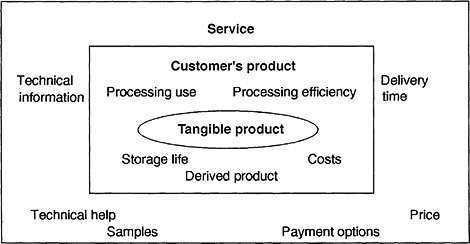FOOD
PRODUCT DEVELOPMENT
Mary Earle, Richard Earle and Allan Anderson |
| Loading
|
|
||||
|
|
Part
2, Chapter 3
The product development process 3.5.3 Industrial food products and services There are two different groups in industrial business-to-business relationships - the industrial buyer (food processor or manufacturer) who employs raw materials and food ingredients in manufacturing a food product, and the industrial supplier of raw materials or ingredients (farmers, primary processors, ingredients processors). There is a great variety of buyers and suppliers, and also a wide variety of products. The product development varies from a branded coffee for one-person coffee bars, which is similar to consumer product development, to the highly specific ingredient for one large multinational food manufacturer. But there are some general factors to consider in developing new industrial products (Schaffner
et al., 1998).
The types of products These could be raw materials from farm and sea, specialised commodities, bulk industrial products, partially processed materials, processed products, processed speciality products. The industrial food-product characteristics The industrial product can be divided into the tangible product, the uses of the product and the services that are marketed with the product. Some important features of industrial food products are shown in Fig. 3.18.  Fig. 3.18 The industrial food product (Source: From Schaffner, Schroder and Earle, Food Marketing: An International Perspective, © 1998, by permission of the McGraw- Hill Companies). There is a tangible product that has specific composition, microbiological levels, physical properties and sensory properties, and there is the customer's product which includes the qualities directly related to the buyer - their uses and also the quality of the derived product made from the raw materials, usually the consumer product. In the customer's product there are also special features, quality and specifications, packaging and branding. Services included implicitly or explicitly with the industrial product can be reliability, safety, availability and replacement, technical information and help, delivery and credit. The service product can also include some or all of the features in the service augmentation and marketing support shown in Fig. 3.15. Products are not just a physical entity but an array of economic, technical and personal relationships between buyer and seller. Industrial buyers Industrial buyers can be grouped together as market segments. The buying company can be buying directly for their own use or for reselling to the users. The users can be segmented as shown in Table 3.8. Table 3.8 Methods for segmenting industrial buyers
The needs and wants of the buyers All buyers are interested in firstly the ease of using the ingredient in the process and secondly the cost and quality of the final products. Although the buying action is logically based on these needs, there are still some psychological reasons for buying. Basic needs and wants of the industrial buyer are shown in Table 3.9. Table 3.9 Needs and wants of the industrial buyer
Actual needs and wants do vary with the different people in the buyer's company. For example:  Production personnel - delivery time, reliability in supply, constant quality, Production personnel - delivery time, reliability in supply, constant quality, ease in processing.  Product development personnel - ease and shorter time for development, Product development personnel - ease and shorter time for development,
final product qualities.  Quality assurance personnel - raw material specifications, ISO Quality assurance personnel - raw material specifications, ISO standards, narrow range of quality variation.  Purchasing personnel - reliability of supply, price, size of delivery, Purchasing personnel - reliability of supply, price, size of delivery, regular deliveries. In looking at these needs, one can see that there is an emphasis on service as well as the product, and this reinforces the need to develop the service with the product. In developing industrial products, there is a need to identify the important people in the buying company as regards this type of ingredient and to find from them their needs and wants in the new ingredient, and decide how their needs and wants relate to the buying company's critical needs. In other words, the product development team in the supplier's company needs to understand the buying company's overall needs in product and services, and also the needs and wants of some individuals. The PD Process The PD Process is therefore a combination of product and service development. In the past, these have been done in sequence, completing the product development process, and then starting the service development. This leads to an increased time for development and also sometimes to a lack of harmony between the product and the service. In Fig. 3.19, there is an attempt to combine the product and service development processes to give an integrated product and service. The integrated product/service development process is particularly useful when new products are being introduced with a new service process and a new service system. The service system may already be in place and a new product and a new service process will be developed. This still means integration of the two development systems. De Brentani (1995) has suggested three successful scenarios for industrial service development:  Customised expert service: expert capabilities and resources Customised expert service: expert capabilities and resources providing customers with customised and high-quality service.  Planned pioneering venture: pioneering new service ventures aimed at Planned pioneering venture: pioneering new service ventures aimed at attractive, high-volume markets.  Improved service experience: enhanced speed, good service quality Improved service experience: enhanced speed, good service quality and reliability.
|
|
 |